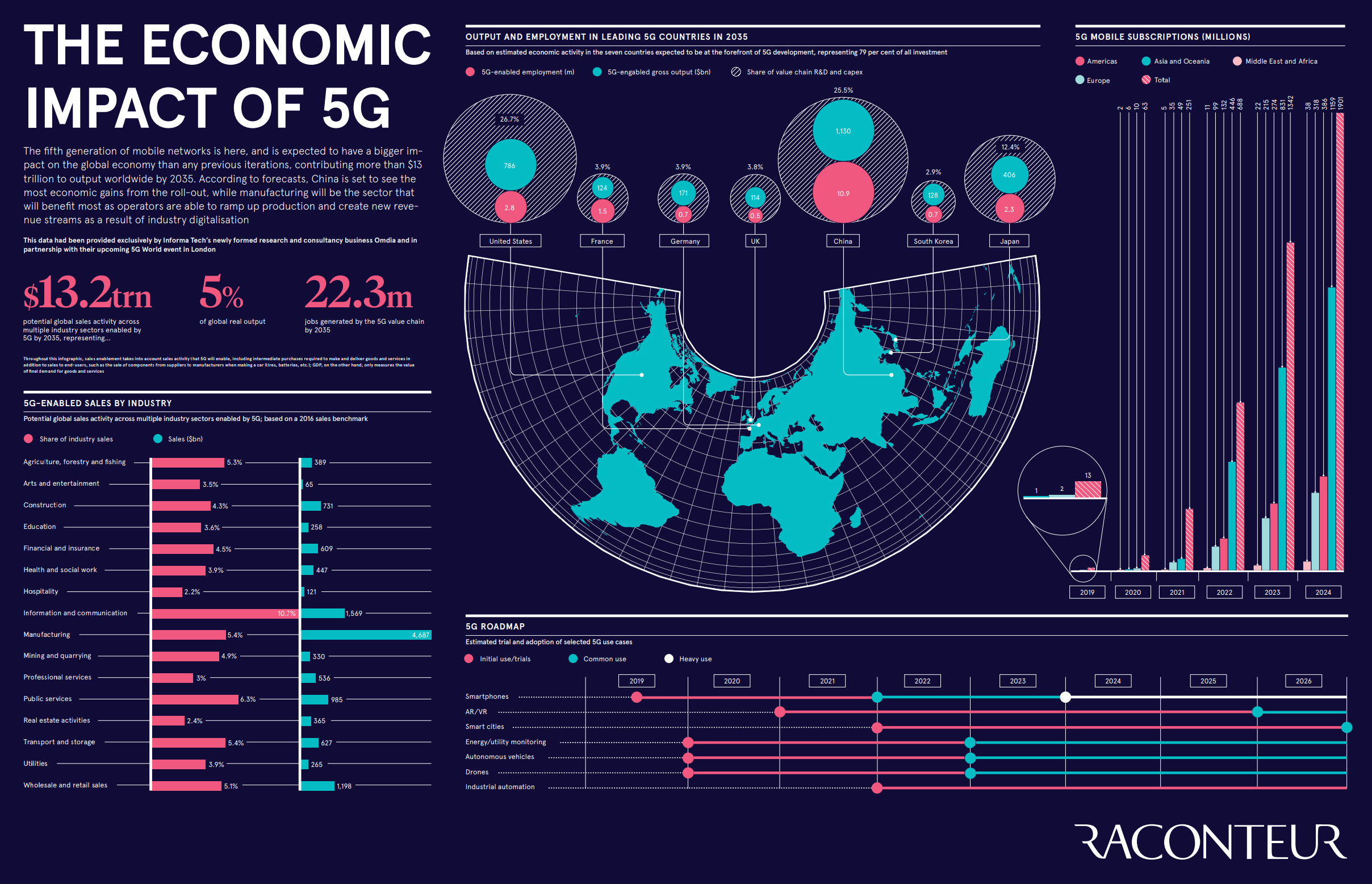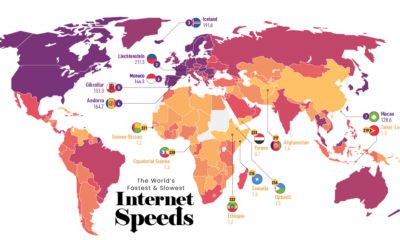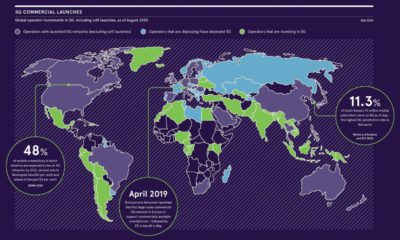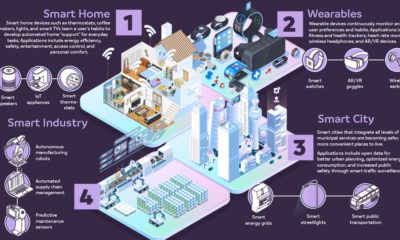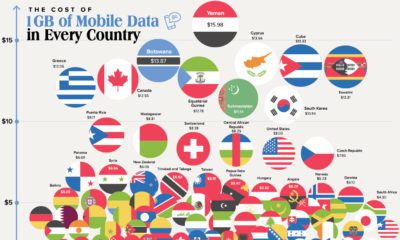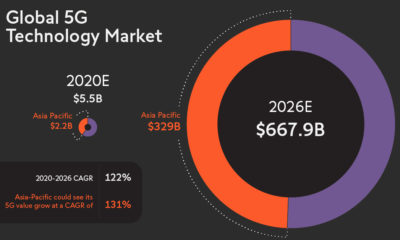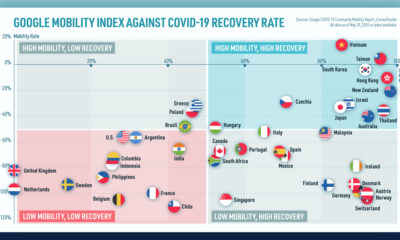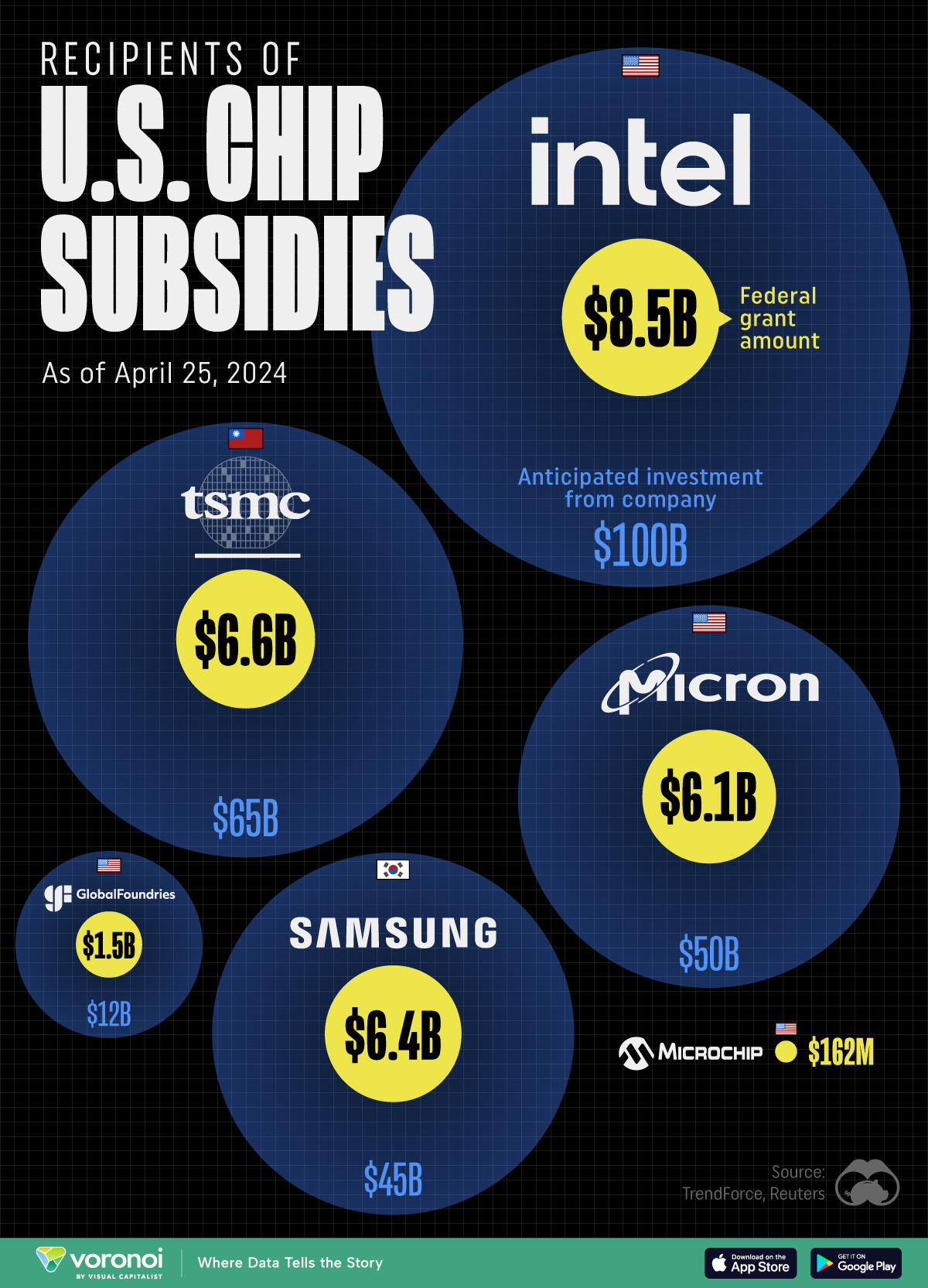Technology
Visualized: Where 5G Will Change The World
View the full-size version of this infographic.
Where 5G Will Change The World
View the high resolution version of this infographic.
We’re on the cusp of a 5G revolution.
Whereas 4G brought us the network speeds necessary for online apps and mobile-streaming, 5G represents a monumental leap forward. Beyond the improvements to our existing ecosystem of devices—more speed and better stability—researchers believe that 5G can serve as the underpinning for fully-connected industries and cities.
Change doesn’t happen overnight, and for us to experience 5G’s true potential, we’ll need to be patient. In light of this, today’s infographic from Raconteur visualizes the forecasted impact of 5G to help us identify the countries and industries that will most effectively leverage its power.
5G-Empowered Industries
5G networks are expected to generate $13.2 trillion in global sales activity by 2035. To make this easier to digest, here are the five industries which stand to benefit the most.
| Rank | Industry | Sales ($B) | Share of Industry Sales (%) |
|---|---|---|---|
| #1 | Manufacturing | $4,687 | 5.4% |
| #2 | Information and Communication | $1,569 | 10.7% |
| #3 | Wholesale and Retail Sales | $1,198 | 5.1% |
| #4 | Public Services | $985 | 6.3% |
| #5 | Construction | $731 | 4.3% |
Let’s focus on manufacturing, an industry which is expected to see a massive $4.6 trillion in 5G-enabled sales.
Efficiency is the name of the game here, and researchers predict that this technology will allow for the world’s first “smart factories”. Such factories would leverage the faster speed and reliability of 5G networks to eliminate cabled connections, improve automated processes, and most importantly, gather more data.
Combined with machine learning algorithms, this data can help companies predict when expensive equipment is about to fail, reducing the likelihood of expensive downtime.
– AT&T Business Editorial
Robots won’t be the only ones to benefit, however. While today’s factories may be lined with machines, humans are still required to be onsite for troubleshooting when issues arise. Some processes may also be too intricate to be effectively automated, thus requiring a human’s touch.
With the lower latencies (shorter delay) boasted by 5G networks, virtual and augmented reality devices can become reliable enough for use in high precision work. This exciting development has the potential to greatly increase a human worker’s productivity, as well as allow them to work in closer harmony with robots.
In fact, such technologies are already being used on factory floors.
Leading The Way
Developing 5G networks and implementing them into the many industries of the global economy is a massive undertaking, and just seven countries are expected to account for 79% of all 5G-related investment.
By 2035, here’s how these countries are expected to rank.
| Country | Share of Value Chain R&D and Capital Expenditure | 5G-enabled Output ($B) | 5G-enabled Employment (million people) |
|---|---|---|---|
| 🇺🇸 United States | 26.7% | $786 | 2.8 |
| 🇨🇳 China | 25.5% | $1,130 | 10.9 |
| 🇯🇵 Japan | 12.4% | $406 | 2.3 |
| 🇩🇪 Germany | 3.9% | $171 | 0.7 |
| 🇫🇷 France | 3.9% | $124 | 1.5 |
| 🇬🇧 United Kingdom | 3.8% | $114 | 0.5 |
| 🇰🇷 South Korea | 2.9% | $128 | 0.7 |
Incidentally, these seven nations are also some of the world’s most innovative economies.
Let’s take a closer look at the two biggest players in 5G development.
United States
It’s not a surprise to see the U.S. on top in terms of 5G investment, though it seems the country is in a peculiar position. China is right on their heels in terms of investment, and is even forecasted to surpass them in 5G-enabled output and employment.
Chinese tech giant Huawei is likely a factor behind these numbers. The company—which America has no direct rival to—is currently the world’s largest manufacturer of telecommunications equipment.
Developments such as these have formed the general consensus that China is winning the “5G race”, but putting America down for a second place finish may be a mistake. With renowned tech hubs like Silicon Valley, the U.S. still leads the rest of the world in terms of patent activity and high-tech company density.
There will be a tendency to cast these developments as another sign that the United States is losing the race … [but] U.S. companies can dominate the applications and services that run over 5G.
– Adam Segal, Director, Council on Foreign Relations
Part of what makes 5G so special is its potential to be used across a wider variety of applications including autonomous vehicles and manufacturing. Perhaps it’s here where American tech firms can use their innovative capacity and software expertise to carve out an advantage.
China
Being the world’s largest manufacturer means China is well-positioned to leverage the power of 5G networks. With nearly 11 million 5G-enabled jobs and over $1.3 trillion in output by 2035, China’s estimates are magnitudes larger than the other countries on this list.
A reason why China is such a cost-efficient place to make things is its well-established network of suppliers, manufacturers, and distributors. All three of these sectors are likely to implement 5G networks for improved speed and efficiency.
China is no slouch when it comes to innovation, either. In terms of patent activity, it ranks second in the world. Shenzhen, once a small fishing village, has become China’s answer to Silicon Valley, and is home to domestic telecom giants like Huawei and ZTE Corporation.
Yet, China faces serious obstacles as it seeks to supply the rest of the world with 5G equipment. Huawei is the subject of U.S. sanctions over allegations of its dealings with Iran. Further skepticism arises from the company’s dubious ownership structure, reliance on state subsidies, and claims of espionage.
Huawei’s quest for dominance in the global telecommunications industry has involved tactics and practices that are antithetical to fair, healthy competition.
– Foreign Policy (magazine)
Regardless of the damage these controversies may cause, China shows no signs of slowing down. The country already holds bragging rights for the world’s largest 5G consumer network, and even claims to have begun research on 6G, an eventual successor to 5G.
The Waiting Game
It’s important to remember that the vast majority of 5G benefits are still years away.
Thus, this next generation of mobile networks can be thought of as an enabling technology—new innovations and complementary technologies will be needed to realize its full potential.
While today’s infographic paints an intuitive visualization of the 5G roadmap, only time will tell which industries and countries actually see the most benefits.
Technology
All of the Grants Given by the U.S. CHIPS Act
Intel, TSMC, and more have received billions in subsidies from the U.S. CHIPS Act in 2024.
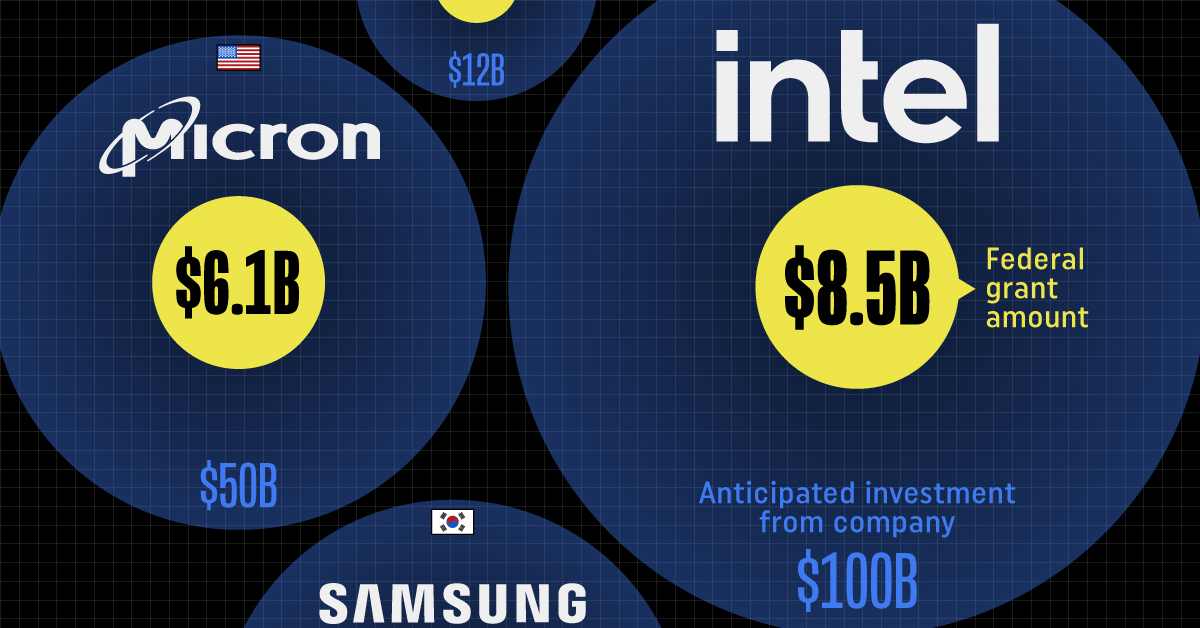
All of the Grants Given by the U.S. CHIPS Act
This was originally posted on our Voronoi app. Download the app for free on iOS or Android and discover incredible data-driven charts from a variety of trusted sources.
This visualization shows which companies are receiving grants from the U.S. CHIPS Act, as of April 25, 2024. The CHIPS Act is a federal statute signed into law by President Joe Biden that authorizes $280 billion in new funding to boost domestic research and manufacturing of semiconductors.
The grant amounts visualized in this graphic are intended to accelerate the production of semiconductor fabrication plants (fabs) across the United States.
Data and Company Highlights
The figures we used to create this graphic were collected from a variety of public news sources. The Semiconductor Industry Association (SIA) also maintains a tracker for CHIPS Act recipients, though at the time of writing it does not have the latest details for Micron.
| Company | Federal Grant Amount | Anticipated Investment From Company |
|---|---|---|
| 🇺🇸 Intel | $8,500,000,000 | $100,000,000,000 |
| 🇹🇼 TSMC | $6,600,000,000 | $65,000,000,000 |
| 🇰🇷 Samsung | $6,400,000,000 | $45,000,000,000 |
| 🇺🇸 Micron | $6,100,000,000 | $50,000,000,000 |
| 🇺🇸 GlobalFoundries | $1,500,000,000 | $12,000,000,000 |
| 🇺🇸 Microchip | $162,000,000 | N/A |
| 🇬🇧 BAE Systems | $35,000,000 | N/A |
BAE Systems was not included in the graphic due to size limitations
Intel’s Massive Plans
Intel is receiving the largest share of the pie, with $8.5 billion in grants (plus an additional $11 billion in government loans). This grant accounts for 22% of the CHIPS Act’s total subsidies for chip production.
From Intel’s side, the company is expected to invest $100 billion to construct new fabs in Arizona and Ohio, while modernizing and/or expanding existing fabs in Oregon and New Mexico. Intel could also claim another $25 billion in credits through the U.S. Treasury Department’s Investment Tax Credit.
TSMC Expands its U.S. Presence
TSMC, the world’s largest semiconductor foundry company, is receiving a hefty $6.6 billion to construct a new chip plant with three fabs in Arizona. The Taiwanese chipmaker is expected to invest $65 billion into the project.
The plant’s first fab will be up and running in the first half of 2025, leveraging 4 nm (nanometer) technology. According to TrendForce, the other fabs will produce chips on more advanced 3 nm and 2 nm processes.
The Latest Grant Goes to Micron
Micron, the only U.S.-based manufacturer of memory chips, is set to receive $6.1 billion in grants to support its plans of investing $50 billion through 2030. This investment will be used to construct new fabs in Idaho and New York.
-

 Debt1 week ago
Debt1 week agoHow Debt-to-GDP Ratios Have Changed Since 2000
-

 Markets2 weeks ago
Markets2 weeks agoRanked: The World’s Top Flight Routes, by Revenue
-

 Countries2 weeks ago
Countries2 weeks agoPopulation Projections: The World’s 6 Largest Countries in 2075
-

 Markets2 weeks ago
Markets2 weeks agoThe Top 10 States by Real GDP Growth in 2023
-

 Demographics2 weeks ago
Demographics2 weeks agoThe Smallest Gender Wage Gaps in OECD Countries
-

 United States2 weeks ago
United States2 weeks agoWhere U.S. Inflation Hit the Hardest in March 2024
-

 Green2 weeks ago
Green2 weeks agoTop Countries By Forest Growth Since 2001
-

 United States2 weeks ago
United States2 weeks agoRanked: The Largest U.S. Corporations by Number of Employees

